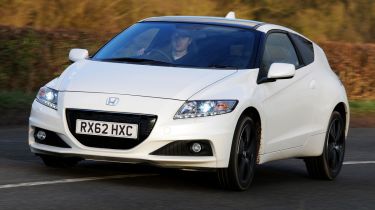Honda CR-Z
The Honda CR-Z has been tweaked to boost power and driver appeal
Perhaps the Mugen version (see panel) will rectify things, but the updated Honda lacks the dynamic appeal of the best cars in the coupé class. The IMA hybrid system fails to deliver enough performance or efficiency to justify its higher price tag. While the CR-Z managed to beat the Renault at the track, there are lots of quicker diesel alternatives around.
Honda has lost its sports car mojo in recent years, but with a brand new NSX supercar looming large on the horizon, hybrid power could be about to take off. The 400bhp, four-wheel-drive NSX promises to be one of the fastest petrol-electric sportscars you can buy – but the little CR-Z was the first.
And now the company has given its pioneering coupe a refresh, promising stronger performance, but no compromise on fuel efficiency. Yet even eagle-eyed Honda enthusiasts will be hard-pressed to separate this new model from the previous CR-Z.
Styling changes to the exterior are subtle, but the futuristic three-door still looks like nothing else on the road. Angular revised bumpers, a reshaped grille and stylish new alloys all enhance its visual appeal. A slim blue strip beneath the Honda badge on the bonnet and a choice of two new paint colours (violet and yellow) round off the changes.
Used - available now

2024 BMW
2 Series Gran Coupe
20,431 milesAutomaticPetrol1.5L
Cash £22,099
2022 Volvo
S60
15,501 milesAutomaticPetrol2.0L
Cash £23,599
2021 Mercedes
A-Class Saloon
9,754 milesAutomaticDiesel2.0L
Cash £22,499
2023 Honda
CR-V
14,943 milesAutomaticPetrol2.0L
Cash £27,060The looks manage to balance throwbacks to the eighties Honda CR-X, such as the split tailgate, with modern touches like LEDs and sharply angled windows. However, the end result isn’t very practical. The spoiler creates a big blind spot, while wide C-pillars mean that even though the CR-Z is shorter and narrower than the Mégane, it’s a bit trickier to park.
Compact dimensions also result in quite limited interior space. The front seats are mounted low to the ground to give a sporty feel, but rear legroom is virtually zero and most buyers are likely to sacrifice the back seats in favour of freeing up the slim boot’s maximum 1,146 litres of luggage space.
Even so, carrying capacity is rarely at the top of a coupe buyer’s wish list, so if the new CR-Z can deliver dynamically, then its cramped and impractical interior shouldn’t count against it in this test.
The rest of the cabin is a mixed bag, with pleasing details like the smart steering wheel and aluminium gearknob clashing with the mismatched dash plastics and confusing console layout. Our GT test car had luxuries like heated leather seats and a panoramic glass roof, but you have to opt for GT trim if you want sat-nav – at a cost of £995.
Fortunately, the biggest changes to the facelifted CR-Z are mechanical, with Honda hoping it can finally deliver on its original promise of highly efficient performance.
Both parts of the integrated motor assist (IMA) hybrid drivetrain have been tweaked in order to provide more power than before. The 1.5-litre petrol engine now produces 119bhp while the electric motor – powered by lithium-ion batteries for the first time – assists with an extra 20bhp. That raises total power from 122bhp to 135bhp, while torque is pumped up by 16Nm to 190Nm.
That doesn’t sound like a huge increase, but Honda claims the CR-Z is now half a second quicker from 0-62mph. We recorded an impressive 8.5-second run from 0-60mph, which underlines this new turn of speed.
The Plus Sport boost system is another improvement, giving an extra burst of electric assistance for around 10 seconds when you prod the steering wheel-mounted S+ button. In practice, we found it offered a noticeable increase in mid-range shove, but only really worked when the batteries had enough charge in them to power the motor.
Yet when you drive the CR-Z quickly, the batteries soon become depleted, and once they go flat, the car feels slower than the Renault Megane Coupe. On the road, the Honda lacks its rival’s refinement, while firm suspension sends it bouncing and jittering over broken tarmac, making for a wearying drive. You also feel the battery’s weight over the rear axle in corners, which can cause the car to feel nervous.
We’d forgive these compromises if the CR-Z was more efficient than its diesel rival, but higher emissions and poor on-test economy of 34.4mpg mean this car’s eco credentials are even less convincing than when it launched in 2010. Factor in a higher price and heavier depreciation compared to the Renault, and the facelifted Honda’s outlook is pretty bleak.







